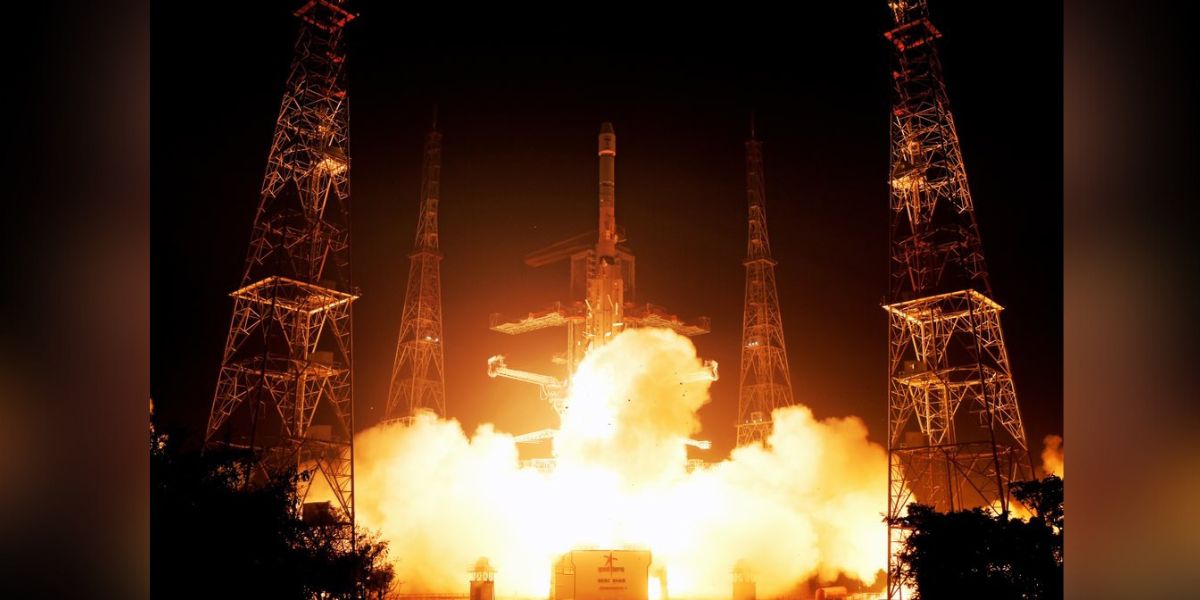The first launch from Sriharikota was on 10 August 1979, with the experimental flight of Satellite Launch Vehicle-3 (SLV-3 E10) carrying the Rohini Technology Payload and the 50th launch was the PSLV-C29 with TeLEOS-1 satellite on 16 December 2015.
Published Jan 29, 2025 | 10:49 AM ⚊ Updated Jan 29, 2025 | 10:50 AM

GSLV F-15 lifting off with NVS-02. (ISRO)
The Indian Space Research Organisation (ISRO) successfully launched the (Geosynchronous Satellite Launch Vehicle) GSLV-F15 with the NVS-02 from Satish Dhawan Space in Sriharikota in Andhra Pradesh at 06.23 am on Wednesday, 29, January.
NVS-02 is a part of India’s Navigation with Indian Constellation (NavIC) and it marked the historic 100th satellite launch from Sriharikota.
“The GSLV-F15/NVS-02 mission has been successfully accomplished. India reaches new heights in space navigation!” ISRO said in a post on X.
✅ Mission Success!
The GSLV-F15/NVS-02 mission has been successfully accomplished.
India reaches new heights in space navigation! 🌟 #GSLV #NAVIC #ISRO
— ISRO (@isro) January 29, 2025
ISRO Chairman Dr V Narayanan said the space agency has accomplished the first launch of this year.
“I am extremely happy to announce from the spaceport of ISRO that the first launch of this year has been successfully accomplished. The GSLV-F15 vehicle launch vehicle precisely injecting the navigation satellite NVS-02 into orbit. This mission is the 100th launch from our launch pads which is a significant milestone for India,” he said, reported The Hindu.
“Our Space programme was conceived and started by a visionary leader Vikram Sarabhai and taken forward by a generation of leaders. Till today, we have developed six generations of launch vehicles. The first launch vehicle was developed under the guidance of Satish Dhawan with APJ Abdul Kalam as the project director in 1979. From that till today, including today’s launch, we have accomplished 100 launches,” he added.
The first launch from Sriharikota was on 10 August 1979, with the experimental flight of Satellite Launch Vehicle-3 (SLV-3 E10) carrying the Rohini Technology Payload and the 50th launch was the PSLV-C29 with TeLEOS-1 satellite on 16 December 2015.
According to ISRO, Navigation with Indian Constellation (NavIC) is India’s independent regional navigation satellite system designed to provide accurate Position, Velocity and Timing (PVT) service to users in India as well as to regions extending about 1500 km beyond the Indian land mass.
“NavIC will provide two types of services, namely, Standard Positioning Service (SPS) and Restricted Service (RS). NavIC’s SPS provides a position accuracy of better than 20 m (2σ) and timing accuracy better than 40 ns (2σ) over the service area,” ISRO said.
GSLV-F15 is the 17th flight of India’s GSLV and the 11th flight with the Indigenous Cryo stage. Wednesday’s launch also marked the eighth operational flight of GSLV.
NVS-01, the first of the second-generation satellites was launched onboard GSLV-F12 on 29 May 2023. For the first time, an indigenous atomic clock was flown in NVS-01.
“NVS-02, the second satellite in the NVS series is configured with Navigation payload in L1, L5 and S bands in addition to ranging payload in C-band like its predecessor-NVS-01. It is configured on standard I-2K bus platform with a lift-off mass of 2250 kg and power handling capability of ~3 kW. It will be placed at 111.75ºE replacing IRNSS-1E. NVS-02 uses a combination of indigenous and procured Atomic clocks for precise time estimation,” ISRO said.
It said the NVS-02 satellite was designed, developed and integrated at UR Satellite Centre (URSC) in Bengaluru with the support of other satellite-based work centres.
The Satish Dhawan Space Centre (SDSC) SHAR, the Spaceport of India, is responsible for providing launch base infrastructure for the Indian space programme.
This centre, located in Sriharikota of Nellore district, has the facilities for solid propellant processing, static testing of solid motors, launch vehicle integration and launch operations, range operations comprising telemetry, tracking and command network and mission control centre.
It has two launch pads from where the rocket launching operations of Polar Satellite Launch Vehicle (PSLV) and GSLV are carried out.
Sriharikota was chosen in 1969 for setting up the rocket launch station of our country. The centre was renamed Satish Dhawan Space Centre SHAR on 5 September 2002, in fond memory of Professor Satish Dhawan, former chairman of ISRO.
“The centre also provides the necessary launch base infrastructure for sounding rockets of ISRO and for assembly, integration and launch of sounding rockets and payloads,” ISRO said.
(Edited by Muhammed Fazil.)
